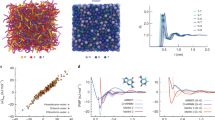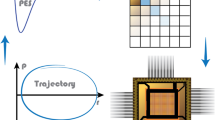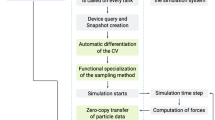Abstract
Hybrid methods that combine quantum mechanics (QM) and molecular mechanics (MM) can be applied to studies of reaction mechanisms in locations ranging from active sites of small enzymes to multiple sites in large bioenergetic complexes. By combining the widely used molecular dynamics and visualization programs NAMD and VMD with the quantum chemistry packages ORCA and MOPAC, we created an integrated, comprehensive, customizable, and easy-to-use suite (http://www.ks.uiuc.edu/Research/qmmm). Through the QwikMD interface, setup, execution, visualization, and analysis are streamlined for all levels of expertise.
This is a preview of subscription content, access via your institution
Access options
Access Nature and 54 other Nature Portfolio journals
Get Nature+, our best-value online-access subscription
$29.99 / 30 days
cancel any time
Subscribe to this journal
Receive 12 print issues and online access
$259.00 per year
only $21.58 per issue
Buy this article
- Purchase on Springer Link
- Instant access to full article PDF
Prices may be subject to local taxes which are calculated during checkout



Similar content being viewed by others
References
Senn, H.M. & Thiel, W. Angew. Chem. Int. Edn Engl. 48, 1198–1229 (2009).
Field, M.J., Bash, P.A. & Karplus, M. J. Comput. Chem. 11, 700–733 (1990).
van der Kamp, M.W. & Mulholland, A.J. Biochemistry 52, 2708–2728 (2013).
Bernardi, R.C. & Pascutti, P.G. J. Chem. Theory Comput. 8, 2197–2203 (2012).
Retegan, M., Neese, F. & Pantazis, D.A. J. Chem. Theory Comput. 9, 3832–3842 (2013).
Coquelle, N. et al. Nat. Chem. 10, 31–37 (2018).
Lin, H. & Truhlar, D.G. Theor. Chem. Acc. 117, 185–199 (2007).
Jindal, G. & Warshel, A. J. Phys. Chem. B 120, 9913–9921 (2016).
Phillips, J.C. et al. J. Comput. Chem. 26, 1781–1802 (2005).
Jiang, W. et al. Comput. Phys. Commun. 185, 908–916 (2014).
Humphrey, W., Dalke, A. & Schulten, K. J. Mol. Graph. 14, 33–38 (1996).
Ribeiro, J.V. et al. Sci. Rep. 6, 26536 (2016).
Fu, H., Shao, X., Chipot, C. & Cai, W. J. Chem. Theory Comput. 12, 3506–3513 (2016).
Stewart, J.J. J. Comput. Aided Mol. Des. 4, 1–105 (1990).
Maia, J.D.C. et al. J. Chem. Theory Comput. 8, 3072–3081 (2012).
Neese, F. Wiley Interdiscip. Rev. Comput. Mol. Sci. 8, e1327 (2018).
Götz, A.W., Clark, M.A. & Walker, R.C. J. Comput. Chem. 35, 95–108 (2014).
Sethi, A., Eargle, J., Black, A.A. & Luthey-Schulten, Z. Proc. Natl. Acad. Sci. USA 106, 6620–6625 (2009).
Black Pyrkosz, A., Eargle, J., Sethi, A. & Luthey-Schulten, Z. J. Mol. Biol. 397, 1350–1371 (2010).
Pan, A.C., Sezer, D. & Roux, B. J. Phys. Chem. B 112, 3432–3440 (2008).
Riplinger, C., Pinski, P., Becker, U., Valeev, E.F. & Neese, F. J. Chem. Phys. 144, 024109 (2016).
Riccardi, D., Li, G. & Cui, Q. J. Phys. Chem. B 108, 6467–6478 (2004).
Warshel, A. & Levitt, M. J. Mol. Biol. 103, 227–249 (1976).
Darden, T., York, D. & Pedersen, L. J. Chem. Phys. 98, 10089–10092 (1993).
Stewart, J.J.P. J. Comput. Chem. 10, 209–220 (1989).
Stewart, J.J.P. J. Comput. Chem. 10, 221–264 (1989).
Sure, R. & Grimme, S. J. Comput. Chem. 34, 1672–1685 (2013).
Singh, U.C. & Kollman, P.A. J. Comput. Chem. 7, 718–730 (1986).
Walker, R.C., Crowley, M.F. & Case, D.A. J. Comput. Chem. 29, 1019–1031 (2008).
Lin, H. & Truhlar, D.G. J. Phys. Chem. A 109, 3991–4004 (2005).
Sherwood, P. et al. Faraday Discuss. 106, 79–92 (1997).
Frisch, M.J. et al. Gaussian 09, Revision A.02. (Gaussian, Inc., 2016).
Titov, A.V., Ufimtsev, I.S., Luehr, N. & Martinez, T.J. J. Chem. Theory Comput. 9, 213–221 (2013).
Shao, Y. et al. Mol. Phys. 113, 184–215 (2015).
Kulik, H.J., Zhang, J., Klinman, J.P. & Martínez, T.J. J. Phys. Chem. B 120, 11381–11394 (2016).
Sekine, S. et al. EMBO J. 22, 676–688 (2003).
Stewart, J.J.P. J. Mol. Model. 19, 1–32 (2013).
Best, R.B. et al. J. Chem. Theory Comput. 8, 3257–3273 (2012).
Dutra, J.D.L., Filho, M.A.M., Rocha, G.B., Simas, A.M. & Freire, R.O. PLoS One 10, e0124372 (2015).
Schoeler, C. et al. Nano Lett. 15, 7370–7376 (2015).
Acknowledgements
The authors thank M.F. Herbst, C. Chipot, and G. Fiorin for helpful discussions. This work was supported by the National Science Foundation (NSF) (grants MCB-1616590, MCB-1244570, and PHY1430124 to Z.L.-S.), the US National Institutes of Health (NIH) (grant P41-GM104601 to Z.L.-S.), the Keck Foundation (grant 206231 to M.C.R.M. and Z.L.-S.), the Alexander von Humboldt Foundation (Feodor Lynen Postdoctoral Fellowship to T.R.), the Brazilian Coordination for Improvement of Higher Educational Personnel (CAPES; fellowship to J.D.C.M.; grant AUXPE1375/2014 to G.B.R.), and the Brazilian National Council for Scientific and Technological Development (CNPq 305271/2013-0 to G.B.R.). F.N. and C.R. acknowledge support for the development of ORCA by the Max Planck society (MPG) and the Germans Science Foundation (DFG). This research made use of Blue Waters sustained-petascale computing, which is supported by the state of Illinois and the NSF (OCI-0725070 and ACI-1238993). This work is part of the Petascale Computational Resource (PRAC) grant, which is supported by the NSF (ACI-1713784).
Author information
Authors and Affiliations
Contributions
M.C.R.M., R.C.B., T.R., K.S., and Z.L.-S. conceived the project. M.C.R.M. implemented the QM–MM interface. R.C.B., T.R., M.C.R.M., G.B.R., and K.S. discussed QM–MM features. J.D.C.M., G.B.R., C.R., and F.N. provided guidance on the development of the QM–MM interface. J.C.P. assisted in adapting NAMD. M.C.R.M. and M.S. prepared Python scripts for the interfaces of selected QM software packages. R.C.B. and M.C.R.M. performed all NAMD tests and simulations. J.D.C.M. and G.B.R. performed Amber calculations. R.C.B. and M.C.R.M. performed all free-energy calculations and analysis. M.S. and J.E.S. implemented the orbital visualization in VMD. J.V.R. and J.E.S. implemented the QM–MM graphical interface in QwikMD. R.C.B., M.C.R.M., T.R., M.S., G.B.R., F.N., and Z.L.-S. wrote and edited the manuscript. K.S. and Z.L.-S. supervised the project.
Corresponding author
Ethics declarations
Competing interests
The authors declare no competing financial interests.
Supplementary information
Supplementary Text and Figures
Supplementary Figures 1–15, Supplementary Tables 1–6 and Supplementary Note (PDF 16186 kb)
Source Data
Supplementary Figure 1 Source Data (XLSX 32 kb)
Source Data
Supplementary Figure 5 Source Data (XLSX 20788 kb)
Source Data
Supplementary Figure 6 Source Data (XLSX 21893 kb)
Source Data
Supplementary Figure 8 Source Data (XLSX 11057 kb)
Source Data
Supplementary Figure 9 Source Data (XLSX 7780 kb)
Source Data
Supplementary Figure 12 Source Data (XLSX 167 kb)
Source Data
Supplementary Figure 13 Source Data (XLSX 34 kb)
Source Data
Supplementary Figure 14 Source Data (XLSX 40 kb)
QM–MM suite investigates the mechanism that sets up the genetic code
NAMD's QM–MM interface was used to investigate the tRNA synthetase GluRS complex with its cognate tRNA and adenylate. Independent QM regions probed the two ends of an allosteric pathway that connects the anti-codon binding region to the active site, and network analysis was used to define the communication pathway, as well as highly correlated atom communities within the QM regions and across the QM–MM barrier. The reaction was studied with a combination of steered MD, string method and eABF, and the most likely mechanism was rendered using new VMD features, along with atomic orbitals calculated using NAMD/ORCA. (MOV 25928 kb)
Source data
Rights and permissions
About this article
Cite this article
Melo, M., Bernardi, R., Rudack, T. et al. NAMD goes quantum: an integrative suite for hybrid simulations. Nat Methods 15, 351–354 (2018). https://doi.org/10.1038/nmeth.4638
Received:
Accepted:
Published:
Issue Date:
DOI: https://doi.org/10.1038/nmeth.4638
This article is cited by
-
Mechanism and biomass association of glucuronoyl esterase: an α/β hydrolase with potential in biomass conversion
Nature Communications (2022)
-
First biphotochromic fluorescent protein moxSAASoti stabilized for oxidizing environment
Scientific Reports (2022)
-
On the quest of small molecules that can mimic Psalmotoxin-1, the most powerful peptidic modulator of the acid sensing channel ASIC1a
Structural Chemistry (2022)
-
Influence of the leaving group on the mechanism of hydrolysis of organophosphorus compounds by phosphotriesterase from bacterium Pseudomonas diminuta
Russian Chemical Bulletin (2022)
-
The role of cysteine residues in the allosteric modulation of the chromophore phototransformations of biphotochromic fluorescent protein SAASoti
Scientific Reports (2021)



